ASM Metals HandBook Vol. 8 - Mechanical Testing and Evaluation
Подождите немного. Документ загружается.

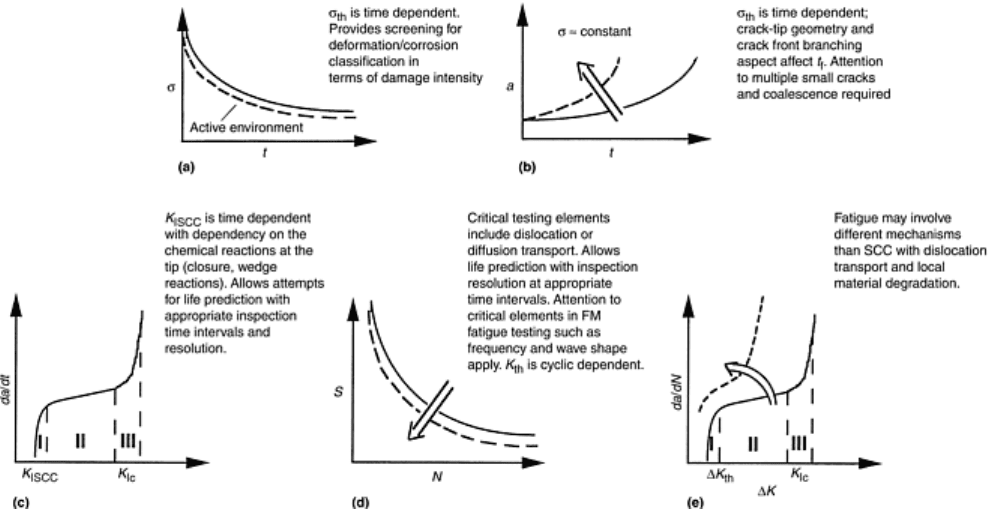
Fig. 13 General types of tests related to stress-corrosion cracking (SCC), hydrogen embrittlement, and
corrosion fatigue. (a) Smooth specimen SCC testing for determination of a stress threshold, σ
th
. (b) Slow-
strain-rate (SSR) testing for strain-rate controlled evaluation of σ
th
and time to failure, t
f
. (c) Fracture
mechanics evaluation with a notched or precracked specimen for determination of crack growth rate
(da/dt) or crack growth threshold (K
ISCC
). (d) Corrosion fatigue life (S-N) testing. (e) Corrosion fatigue
crack growth testing for determination of crack growth rates of fatigue cracking threshold (ΔK
th
)
If the objective of testing is to predict the service behavior or to screen alloys for service in a specific
environment, it is often necessary to obtain SCC information in a relatively short time. This requires
acceleration of testing by increasing the severity of the environment or the critical test parameters. The former
can be accomplished by increasing the test temperature or the concentration of corrosive species in the test
solution and by electrochemical stimulation. Test parameters that can be changed to reduce the testing time
include the application of higher stresses, continuous straining, and precracking, which allows bypassing the
crack nucleation phase of the SCC process.
Stress-corrosion specimens can be divided into two main categories, namely smooth, and precracked or notched
specimens. Further distinction can be made in the loading mode, such as constant deflection, constant load, and
constant extension or strain rate. These different loading modes are briefly reviewed in the following sections.
More detailed information is in Ref 76.
Important parameters during SCC testing include the orientation grain flow direction relative to stressing
direction, surface condition, and residual stress. The nucleation of stress-corrosion cracks strongly depends on
initial surface reactions, and thus the surface condition of the test specimens, particularly smooth specimens,
has a significant effect on the test results. Smooth test specimens are often tested with a mechanically
(machined or abraded) or (electro) chemically treated surface. It is very important to avoid or to remove
machining marks or scratches perpendicular to the loading direction (per ASTM G 1, “Standard Practice for
Preparing, Cleaning, and Evaluating Corrosion Test Specimens”).
Reference cited in this section
76. D. Sprowls, Evaluation of Stress Corrosion Cracking, Stress Corrosion Cracking, Materials
Performance and Evaluation, ASM International, 1992, p 363–416

Evaluation of Environmentally Assisted Crack Growth
Y. Katz, N. Tymiak, and W.W. Gerberich, University of Minnesota
Smooth Specimen SCC Testing
Smooth SCC specimens allow for the evaluation of the total SCC life, which includes crack nucleation and
propagation. Testing can be conducted under constant extension or strain, constant load, and constant extension
or strain rate. The selection of a specific test method for SCC strongly depends on the particular service
application and the time allowed for testing.
Constant Extension Testing
Constant extension or constant strain tests on smooth specimens are widely used and do not require elaborate
testing fixtures. Depending on the specific configuration of the test articles, different types of constant
extension tests are being used, the most common being bent-beam, U-bend, C-ring, and tensile type specimens.
The simplest method of providing a constant load consists of a deadweight hung on one end of the specimen.
This method is particularly useful for wire specimens. For specimens of larger cross section, however, lever
systems such as those used in creep-testing machines are more practical. The primary advantage of any
deadweight loading device is the constancy of the applied load.
Constant-strain SCC tests are performed in low-compliance tension-testing machines. The specimen is loaded
to the required stress level, and the moving beam is then locked in position. Other laboratory stressing frames
have been used, generally for testing specimens of smaller cross section.
Bent-Beam Specimens. The different types of bent-beam specimens are illustrated in Fig. 14. These specimens
may be used to test sheet plate and flat extruded material, or wires and extrusions with a circular cross section.
The figure shows that bending can be accomplished in several ways depending on the dimensions of the
specimen. Stressing of the specimen is accomplished by bending the specimen in a stressing device, while
restraining the ends. During stress-corrosion testing, both specimen and stressing device are exposed to the test
environment. The most simple loading arrangement is the two-point loaded bent beam, which can only be used
on relatively thin sheet or wire material. The elastic stress at the mid-point of the specimen can be estimated
from the following equation:
L = (ktE/σ) sin
-1
(H/HktE)
where Lis the specimen length, σ is the maximum stress, E is the elastic modulus, H is the length of holder, t is
the specimen thickness, and k is the empirical constant (1.280).
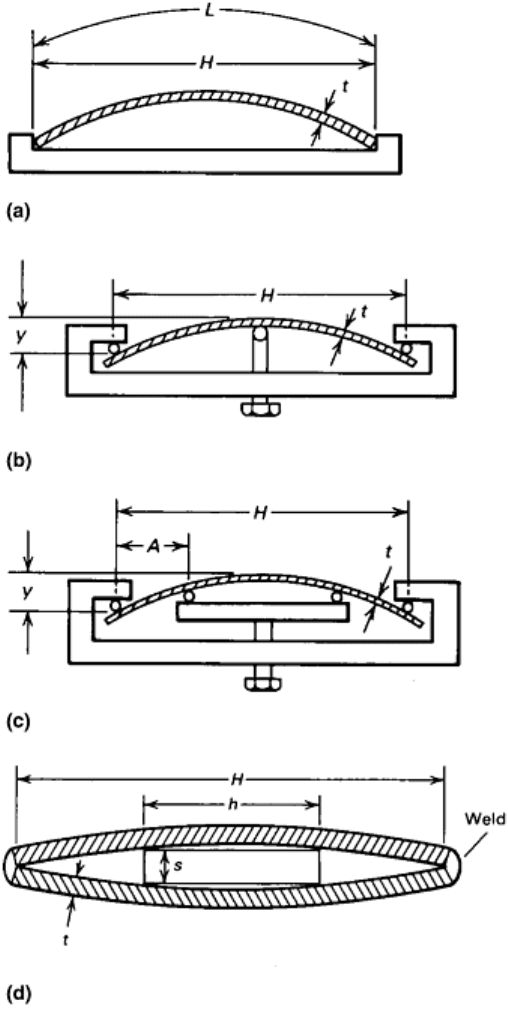
Fig. 14 Schematic specimen and holder configurations for bent-beam specimens. (a) Two-point loaded
specimen. (b) Three-point loaded specimen. (c) Four-point loaded specimen. (d) Welded double-beam
specimen. Source: ASTM G 9
Three-Point Bend Specimens. Three-point bend tests are commonly used because of the ease of load
application and the ability to use the same loading rigs for different stresses. The load is applied by turning a
bolt in the rig, deflecting the specimen. The elastic stress at the mid-point of the specimen is calculated from the
following equation:
σ = 6Ety/H
2
where σ is the maximum tensile stress, E is the elastic modulus, t is the specimen thickness, y is the maximum
deflection, and H is the length of holder.
This test has a number of disadvantages. First, dissimilar metal corrosion and/or crevice corrosion can occur
under the bolt. Secondly, once the crack has formed, the stress condition changes such that the outer layer of the
specimen is not subject to a tensile stress only, but to a complex combination at tensile and bending stresses.
The propagating crack will then deviate from the centerline. Thus, the three-point bend test can only be used as
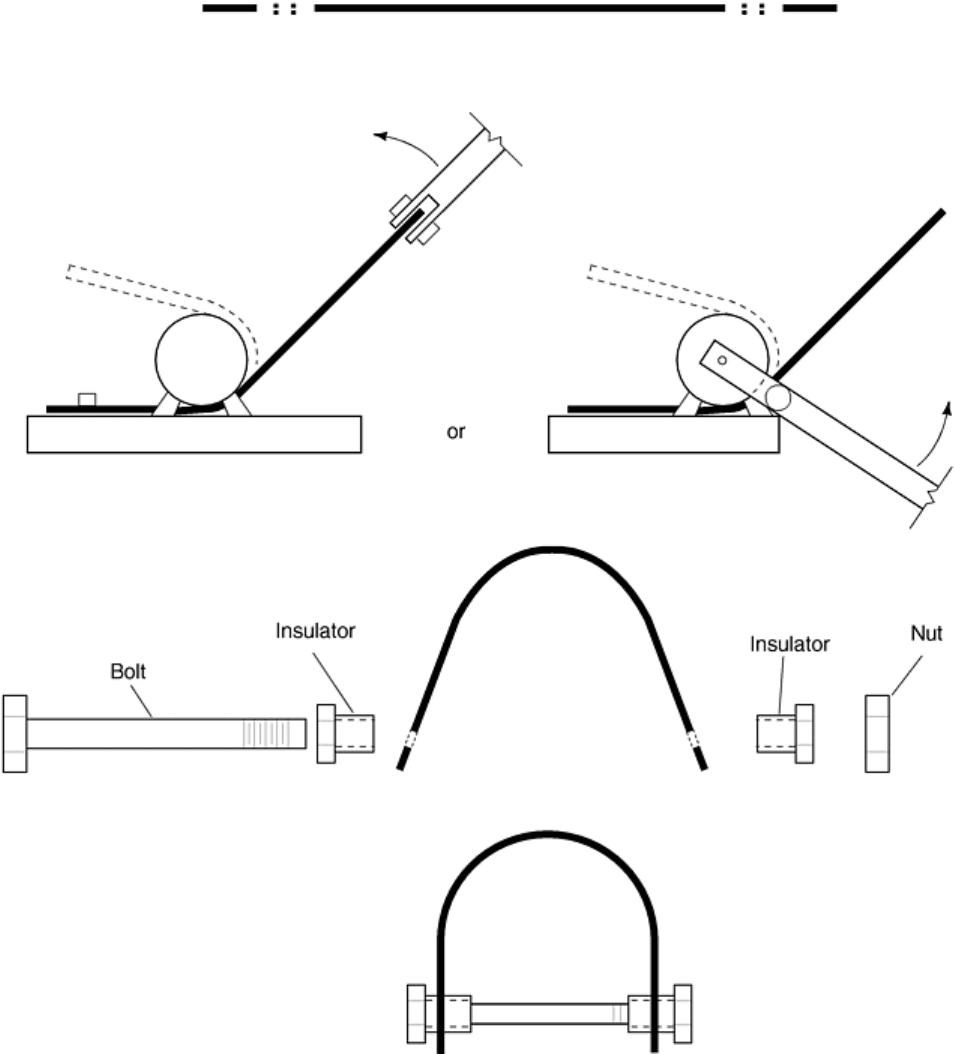
a qualitative test to assess the susceptibility to stress-corrosion cracking. With the four-point bend test,
described in the next paragraph, tensile stresses can be maintained during the growth of the crack.
Four-Point Bend Specimens. Four-point bend testing provides a uniform tensile stress over a relatively large
area of the specimen. The elastic stress in the outer layer of the specimen between the two inner supports can be
calculated from the following equation:
σ = 12Ety/(3H
2
- 4A
2
)
where σ is the maximum tensile stress, E is the elastic modulus, t is the specimen thickness, y is the maximum
deflection, H is the distance between outer supports, and A is the distance between outer and inner supports.
U-bend specimens are prepared by bending a strip 180° around a mandrel with a predetermined radius (Fig.
15). The figure shows that bends less than 180° degrees are also used. Standardized test methods are described
in ASTM G 30. Because of the ease of fabrication, a large amount of specimens can be fabricated, and this test
is therefore widely used to qualitatively evaluate the susceptibility of alloy and heat treatment to stress-
corrosion cracking.
Fig. 15 Schematic two-stage stressing of a U-bend specimen. Source: ASTM G 30
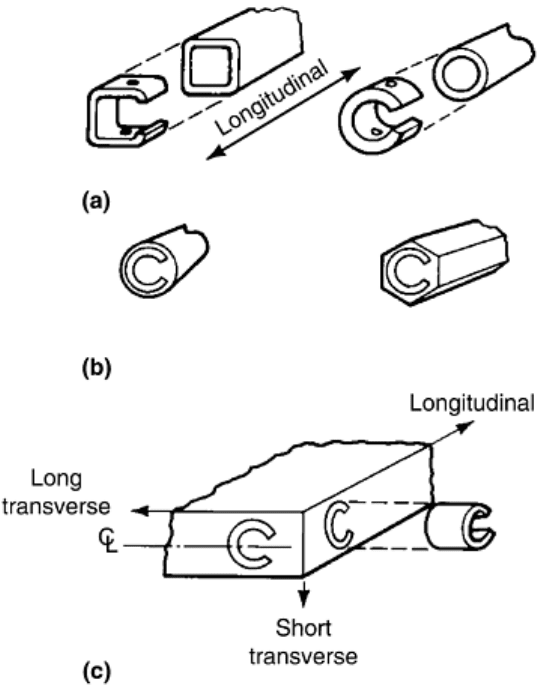
A good approximation of the strain at the apex of the U-bend is:
ε = t/2R, when t < R
where t is the specimen thickness and R is the radius of the bend. Then, an appropriate value for the maximum
stress can be obtained from the stress-strain curve of the test material.
C-ring specimens are commonly used to determine the susceptibility to stress-corrosion cracking of alloys in
different product forms. This test is particularly useful for testing of tubing, rod, and bar in the short-transverse
direction, as illustrated in Fig. 16. The specimens are typically bolt loaded to a constant strain or constant load
per ASTM G 338. If the stresses in the outer layers of the apex of the C-rings are in the elastic region, the
stresses can be accurately calculated using the following equations:
D
f
= D - Δ
where
Δ = σd
2
/4EtZ
and where D is the outer diameter of the C-ring before stressing, D
f
is the outer diameter of stressed C-ring, σ is
the elastic stress, Δ is the change of D at the desired stress, d is the mean diameter (D - t), t is the wall thickness,
E is the elastic modulus, and Z is the correction factor for curved beam.
Fig. 16 Sampling procedure for testing various products with C-rings. (a) Tube. (b) Rod and bar. (c)
Plate. Source: ASTM G 338
The stress on C-ring specimens can be more accurately determined by attaching circumferential and transverse
strain gages to the stressed surface. The circumferential (σ
C
) and transverse (σ
T
) elastic stresses can be
calculated with (Ref 82 and 83):
σ
C
= E/(1 - μ
2
) × (ε
C
+ με
T
)
σ
T
= E/(1 - μ
2
) × (ε
T
+ με
C
)
where E is the elastic modulus, μ is the Poisson's ratio, ε
C
is the circumferential strain, and ε
T
is the transverse
strain.
Tensile Specimens. For specific purposes, such as alloy development, a large number of stress-corrosion
specimens need to be evaluated. Tensile specimens have been used for this purpose where specimens used to
determine tensile properties in air are adapted to SCC, as discussed in ASTM G 49. When uniaxially loaded in
tension, the stress pattern is simple and uniform, and the magnitude of the applied stress can be accurately
determined. Specimens can be quantitatively stressed by using equipment for application of either a constant
load, a constant strain, or an increasing load or strain.
This type of test is one of the most versatile methods of SCC testing because of the flexibility permitted in the
type and size of the test specimen, the stressing procedures, and the range of stress level. It allows the
simultaneous exposure of unstressed specimens (no applied load) with stressed specimens and subsequent
tension testing to distinguish between the effects of true SCC and mechanical overload.
A wide range of test specimen sizes can be used, depending primarily on the dimensions of the product to be
tested. Stress-corrosion test results can be significantly influenced by the cross section of the test specimen.
Although large specimens may be more representative of most structures, they often cannot be prepared from
the available product forms being evaluated. They also present more difficulties in stressing and handling in
laboratory testing.
Smaller cross-sectional specimens are widely used. They have a greater sensitivity to SCC initiation, usually
yield test results rapidly, and permit greater convenience in testing. However, the smaller specimens are more
difficult to machine, and test results are more likely to be influenced by extraneous stress concentrations
resulting from nonaxial loading, corrosion pits, and so on. Therefore, use of specimens less than about 10 mm
(0.4 in.) in gage length and 3 mm (0.12 in.) in diameter is not recommended, except when testing wire
specimens.
Tension specimens containing machined notches can be used to study SCC and hydrogen embrittlement. The
presence of a notch induces a triaxial stress state at the root of the notch, in which the actual stress will be
greater by a concentration factor that is dependent on the notch geometry. The advantages of such specimens
include the localization of cracking to the notch region and acceleration of failure. However, unless directly
related to practical service conditions, the results may not be relevant.
Tension specimens can be subjected to a wide range of stress levels associated with either elastic or plastic
strain. Because the stress system is intended to be essentially uniaxial (except in the case of notched
specimens), great care must be exercised in the construction of stressing frames to prevent or minimize bending
or torsional stresses.
Constant Load Testing
Although the constant extension tests are widely used for evaluating the susceptibility of alloys to stress-
corrosion cracking because of the ease of specimen preparation and the ability to test a large number of
specimens at one time, there is one major drawback. Once stress-corrosion cracks have formed, the gross cross
section stress decreases, which will eventually cause the crack to stop. Application of a constant or a static load
provides an alternative test method that represents some actual field conditions that can provide threshold
values. It should be cautioned, however, that such threshold values are strongly dependent on the method of
loading (i.e., deadweight or spring) and the specimen size and cannot be considered a material property.
Moreover, Fig. 17 and (Ref 84) shows that as a crack develops, the stress at the crack tip increases, possibly
decreasing the time to failure.
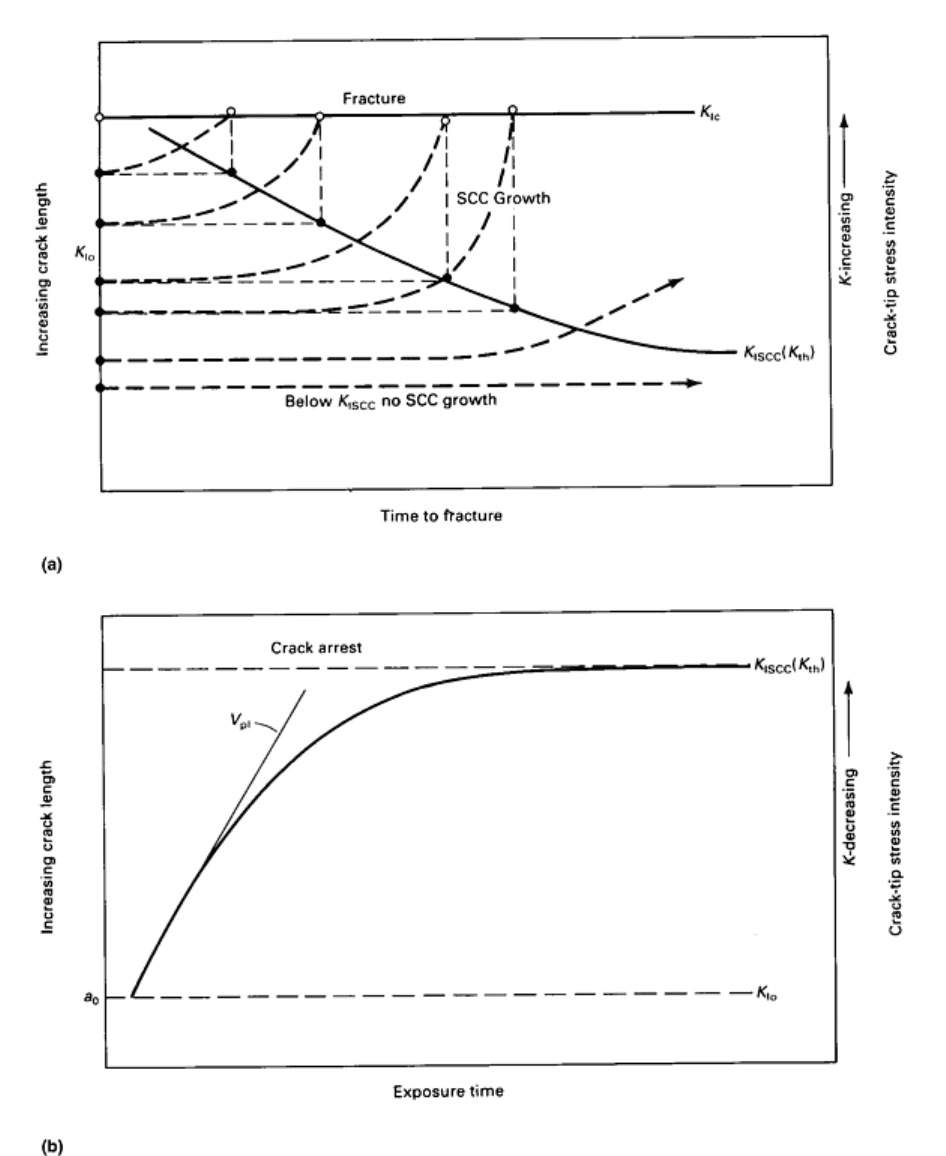
Fig. 17 Schematic comparison of determination of threshold stress integrity factor (K
Iscc
or K
th
). (a)
Constant-load (K-increasing) test. (b) Constant crack opening displacement (K-decreasing) test. Source:
Ref 84
Constant Strain Rate Testing
Constant or slow-strain-rate testing is a very useful technique to evaluate the susceptibility of materials to SCC
in a relatively short period of time (Ref 84 and 85). Typical strain rates range between 10
-5
s
-1
and 10
-7
s
-1
, but
for most materials the typical strain rate is at 10
-6
s
-1
. The strain sensitivity to SCC can change for different
alloys, even of the same metal. Figure 18 (Ref 85) shows that for the 2000 series aluminum alloys, the critical
strain rate for the highest susceptibility to cracking is 10
-6
s
-1
, whereas no such critical strain rate exists for the
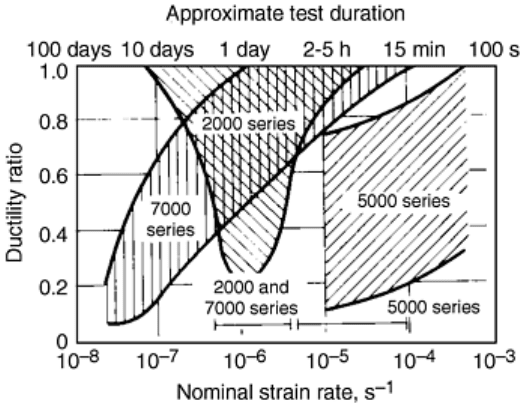
7000 series aluminum alloys. This difference in slow-strain-rate behavior of the two alloys may indicate
different mechanisms for SCC. The slow-strain-rate behavior indicates that the principal mechanism for
cracking of the 2000 series alloys is film rupture—anodic dissolution model, while the predominant mechanism
for cracking of the 7000 series alloys is hydrogen embrittlement.
Fig. 18 Strain rate regimes for SCC of 2000, 5000, and 7000 series aluminum alloys in a 3% aqueous
NaCl solution plus 0.3% H
2
O
2
. Source: Ref 85
The parameters that are typically measured in slow-strain-rate testing to determine the susceptibility to SCC
are:
• Time to failure
• Percent elongation
• Percent reduction in cross-sectional area at the fracture surface
• Reduction in ultimate and yield tensile stress
• Presence of secondary cracking on the specimen gage section
• Appearance of the fracture surface
In order to assess the susceptibility of a material to SCC, the results of the slow-strain-rate test in a particular
environment must be compared with those in an inert environment, such as dry nitrogen gas.
References cited in this section
82. Stress Corrosion Testing, STP 425, ASTM, 1967, p 3
83. H.L. Craig, D.O. Sprowls, and D.E. Piper, Handbook on Corrosion Testing and Evaluation, W.H. Ails,
Ed., John Wiley and Sons, 1976, p 213
84. G. Vogt, Werkstoff. Korros., Vol 29, 1978, p 721
85. N.J.H. Holroyd and G.M. Scamans, Slow-Strain Rate Stress Corrosion Testing of Aluminum Alloys,
Environment-Sensitive Fracture, STP 821, S.V. Dean, E.N. Pugh, and G.M. Ugianski, Ed., ASTM,
1984, p 202

Evaluation of Environmentally Assisted Crack Growth
Y. Katz, N. Tymiak, and W.W. Gerberich, University of Minnesota
Precracked Specimen Testing
The use of precracked specimens in the evaluation of SCC is based on the engineering concept that all
structures contain cracklike flaws. Moreover, precracking can contribute to the susceptibility to SCC of alloys
such as titanium alloys, and this susceptibility may not always be evident from smooth specimens.
Precracking eliminates the uncertainties that are associated with crack nucleation and can provide a flaw
geometry for which a stress analysis is available through fracture mechanics. Expressing stress-corrosion
characteristics in terms of fracture mechanics provides a relationship between applied stress, crack length, and
crack growth in a corrosive environment. When the plasticity can be ignored, or in other words, when the
plastic zone ahead of the propagating crack is below a certain value and a triaxial or plane strain stress state
exists at the crack tip, linear elastic fracture mechanics (LEFM) can be applied to describe the relationship
between crack length (a) and the applied stress (σ) by the stress-intensity factor K:
K = Fσ ·
where F is a polynomial factor that accounts for the specimen geometry. Linear elastic fracture mechanics, and
thus the K factor, cannot be used to describe the relationship between applied stress and the crack length when
there is significant plasticity or when the stress state at the crack tip is plane stress. Then, a more fundamental
parameter, the J integral, is used.
Almost all standard plane strain fracture mechanics test specimens can be adapted to SCC testing. Several
examples are illustrated schematically in Fig. 19 (Ref 76). ASTM E 399 describes the allowable specimen
dimensions and test procedures for precracked specimens.
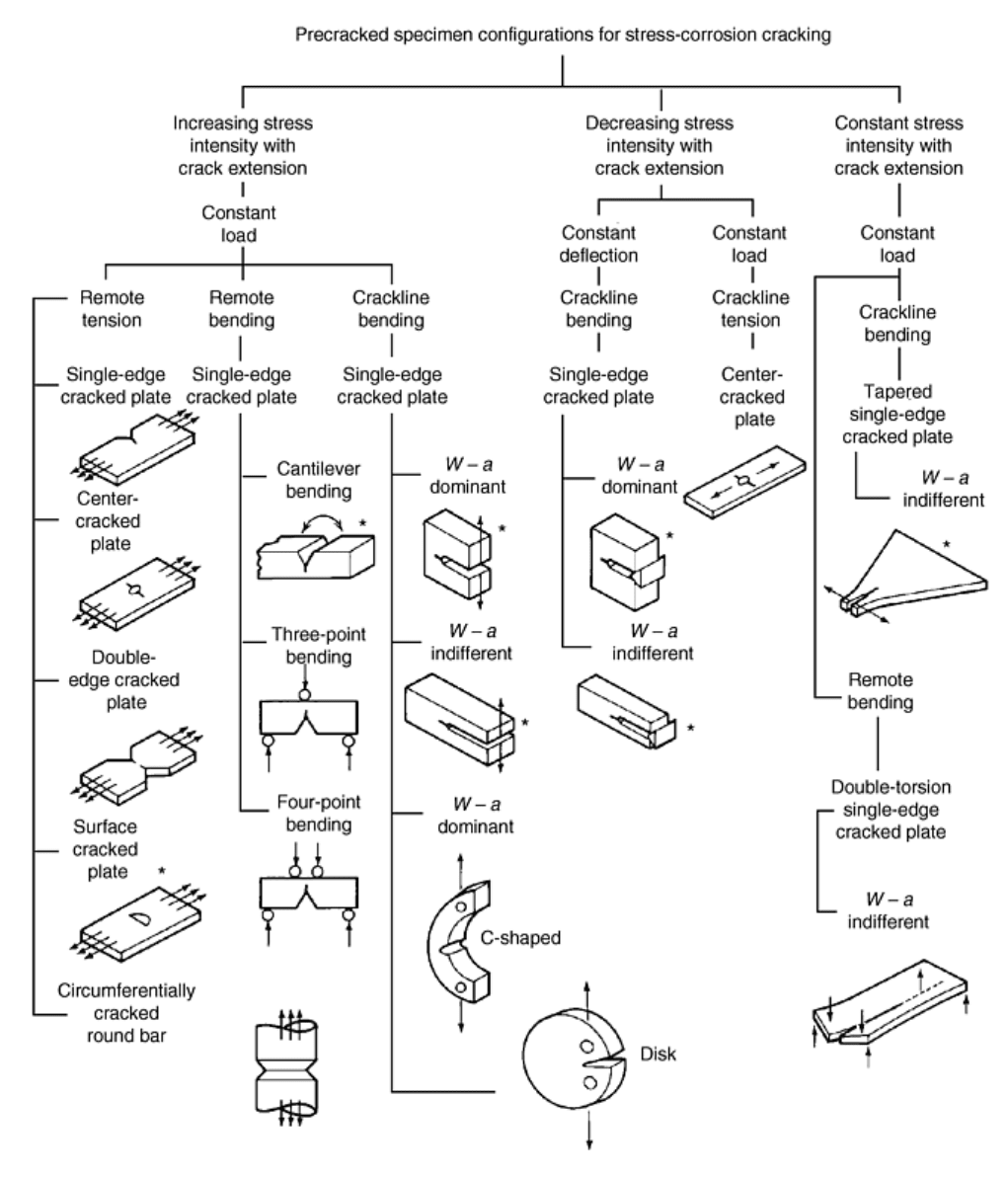
Fig. 19 Classification of precracked specimens for SCC testing. Source: Ref 76
Specimen Preparation. When using precracked fracture mechanics specimens, specific dimensional
requirements need to be considered, as well as crack configuration and orientation. The basic dimensional
requirement for application of LEFM is that dimensions are such that plane strain condition can be maintained.
In general, for a valid K measurement, neither that crack length nor the specimen thickness should be less than
2.5 (K
Ic
/σ
Y
)
2
.
Several designs of initial crack configuration are available. ASTM E 399 recommends that the notch root radius
is not greater than 0.127 mm (0.005 in.), unless a chevron notch is used, in which case it may be 0.25 mm (0.01
in.). In order to start out with a crack as sharp as possible, ASTM E 399 describes procedures for precracking.
